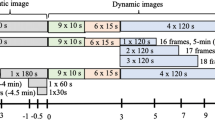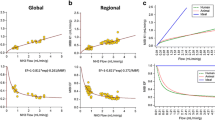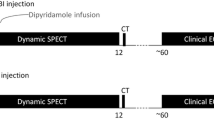Abstract
Background
The objective of this study was to measure myocardial blood flow (MBF) in humans using 99mTc-tetrofosmin and dynamic single-photon emission computed tomography (SPECT).
Methods
Dynamic SPECT using 99mTc-tetrofosmin and dynamic positron emission tomography (PET) was performed on a group of 16 patients. The SPECT data were reconstructed using a 4D-spatiotemporal iterative reconstruction method. The data corresponding to 9 patients were used to determine the flow-extraction curve for 99mTc-tefrofosmin while data from the remaining 7 patients were used for method validation. The nonlinear tracer correction parameters A and B for 99mTc-tefrofosmin were estimated for the 9 patients by fitting the flow-extraction curve \( K_{1} = F\left( {1 - A \exp \left( { - \frac{B}{F}} \right)} \right) \) for K 1 values estimated with 99mTc-tefrofosmin using SPECT and MBF values estimated with 13N-NH3 using PET. These parameters were then used to calculate MBF and coronary flow reserve (CFR) in three coronary territories (LAD, RCA, and LCX) using SPECT for an independent cohort of 7 patients. The results were then compared with that estimated with 13N-NH3 PET. The flow-dependent permeability surface-area product (PS) for 99mTc-tefrofosmin was also estimated.
Results
The estimated flow-extraction parameters for 99mTc-tefrofosmin were found to be A = 0.91 ± 0.11, B = 0.34 ± 0.20 (R 2 = 0.49). The range of MBF in LAD, RCA, and LCX was 0.44-3.81 mL/min/g. The MBF between PET and SPECT in the group of independent cohort of 7 patients showed statistically significant correlation, r = 0.71 (P < .001). However, the corresponding CFR correlation was moderate r = 0.39 yet statistically significant (P = .037). The PS for 99mTc-tefrofosmin was (0.019 ± 0.10)*MBF + (0.32 ± 0.16).
Conclusions
Dynamic cardiac SPECT using 99mTc-tetrofosmin and a clinical two-headed SPECT/CT scanner can be a useful tool for estimation of MBF.







Similar content being viewed by others
Abbreviations
- MBF:
-
Myocardial blood flow
- MPI:
-
Myocardial perfusion imaging
- CAD:
-
Coronary artery disease
- CFR:
-
Coronary flow reserve
- MPI:
-
Myocardial perfusion index
- PCI:
-
Percutaneous coronary intervention
- CABG:
-
Coronary artery bypass graft
- LEHR:
-
Low-energy high-resolution
- PSF:
-
Point-spread-function
- TACs:
-
Time activity curves
References
Shaw LJ, Iskandrian AE. Prognostic value of gated myocardial perfusion SPECT. J Nucl Cardiol 2004;11:171-85.
Berman DS, Kang X, Slomka PJ, Gerlach J, de Yang L, Hayes SW, et al. Underestimation of extent of ischemia by gated SPECT myocardial perfusion imaging in patients with left main coronary artery disease. J Nucl Cardiol 2007;14:521-8.
Schindler TH, Quercioli A, Valenta I, Ambrosio G, Wahl RL, Dilsizian V. Quantitative assessment of myocardial blood flow—clinical and research applications. Semin Nucl Med 2014;44:274-93.
Murthy VL, Naya M, Foster CR, Hainer J, Gaber M, Di Carli G, et al. Improved cardiac risk assessment with noninvasive measures of coronary flow reserve. Circulation 2011;124:2215-24.
Zeiher AM, Drexler H, Wollschlager H, Just H. Endothelial dysfunction of the coronary microvasculature is associated with coronary blood flow regulation in patients with early atherosclerosis. Circulation 1991;84:1984-92.
Danad I, Raijmakers PG, Appelman YE, Harms HJ, de Haan S, van den Oever ML, Heymans MW, Tulevski II, van Kuijk C, Hoekstra OS, et al. Hybrid imaging using quantitative H215O PET and CT-based coronary angiography for the detection of coronary artery disease. J Nucl Med 2013;54:55-63.
Waller AH, Blankstein R, Kwong RY, Di Carli MF. Myocardial blood flow quantification for evaluation of coronary artery disease by positron emission tomography, cardiac magnetic resonance imaging, and computed tomography. Curr Cardiol Rep 2014;16:483.
Ben-Haim S, Murthy VL, Breault C, Allie R, Sitek A, Roth N, et al. Quantification of myocardial perfusion reserve using dynamic SPECT imaging in humans: A feasibility study. J Nucl Med 2013;54:873-9.
Wells RG, Timmins R, Klein R, Lockwood J, Marvin B, deKemp RA, et al. Dynamic SPECT measurement of absolute myocardial blood flow in a porcine model. J Nucl Med 2014;55:1685-91.
Petretta M, Storto G, Pellegrino T, Bonaduce D, Cuocolo A. Quantitative assessment of myocardial blood flow with SPECT. Prog Cardiovasc Dis 2015;57:607-14.
Gullberg GT, Reutter BW, Sitek A, Maltz JS, Budinger TF. Dynamic single photon emission computed tomography—basic principles and cardiac applications. Phys Med Biol 2010;55:R111-91.
Shrestha U, Alhassen F, Seo Y, Botvinick EH, Gullberg GT. Reconstruction of gated dynamic cardiac SPECT data using spatiotemporal basis functions. In: 2012 IEEE Nuclear Science Symposium and Medical Imaging Conference Record (NSS/MIC). 2012. p. 2489-92.
Reutter BW, Gullberg GT, Huesman RH. Direct least-squares estimation of spatiotemporal distributions from dynamic SPECT projections using a spatial segmentation and temporal B-splines. IEEE Trans Med Imaging 2000;19:434-50.
Fang YH, Muzic RF Jr. Spillover and partial-volume correction for image-derived input functions for small-animal 18F-FDG PET studies. J Nucl Med 2008;49:606-14.
Hutchins GD, Schwaiger M, Rosenspire KC, Krivokapich J, Schelbert H, Kuhl DE. Noninvasive quantification of regional blood flow in the human heart using N-13 ammonia and dynamic positron emission tomographic imaging. J Am Coll Cardiol 1990;15:1032-42.
van den Hoff J, Burchert W, Borner AR, Fricke H, Kuhnel G, Meyer GJ, et al. [1-(11)C]acetate as a quantitative perfusion tracer in myocardial PET. J Nucl Med 2001;42:1174-82.
Schelbert HR, Phelps ME, Huang SC, Macdonald NS, Hansen H, Kuhl DE. N-13 ammonia as an indicator of myocardial blood-flow. Circulation 1981;63:1259-72.
Crone C. The permeability of capillaries in various organs as determined by use of the ‘indicator diffusion’ method. Acta Physiol Scand 1963;58:292-305.
Renkin EM. Transport of potassium-42 from blood to tissue in isolated mammalian skeletal muscles. Am J Physiol 1959;197:1205-10.
Bassingthwaighte JB. A concurrent flow model for extraction during transcapillary passage. Circ Res 1974;35:483-503.
Slomka PJ, Berman DS, Germano G. Absolute myocardial blood flow quantification with SPECT/CT: Is it possible? J Nucl Cardiol 2014;21:1092-5.
Nekolla SG, Rischpler C, Nakajima K. Myocardial blood flow quantification with SPECT and conventional tracers: A critical appraisal. J Nucl Cardiol 2014;21:1089-91.
Koshino K, Fukushima K, Fukumoto M, Hori Y, Moriguchi T, Zeniya T, et al. Quantification of myocardial blood flow using (201)Tl SPECT and population-based input function. Ann Nucl Med 2014;28:917-25.
Chareonthaitawee P, Kaufmann PA, Rimoldi O, Camici PG. Heterogeneity of resting and hyperemic myocardial blood flow in healthy humans. Cardiovasc Res 2001;50:151-61.
Husain SS. Myocardial perfusion imaging protocols: Is there an ideal protocol? J Nucl Med Technol 2007;35:3-9.
Hsu B, Chen FC, Wu TC, Huang WS, Hou PN, Chen CC, et al. Quantitation of myocardial blood flow and myocardial flow reserve with 99mTc-sestamibi dynamic SPECT/CT to enhance detection of coronary artery disease. Eur J Nucl Med Mol Imaging 2014;41:2294-306.
Vanderheyden M, Bartunek J, Verstreken S, Mortier L, Goethals M, de Bruyne B. Non-invasive assessment of coronary flow reserve in idiopathic dilated cardiomyopathy: Hemodynamic correlations. Eur J Echocardiogr 2005;6:47-53.
Abdalah M, Boutchko R, Mitra D, Gullberg GT. Reconstruction of 4-D dynamic SPECT images from inconsistent projections using a spline initialized FADS algorithm (SIFADS). IEEE Trans Med Imaging 2015;34:216-28.
Acknowledgments
Authors would like to thank nuclear medicine technologists and clinical staff at the UCSF Imaging Center at China Basin local facility for conducting patient scans and Astellas Pharma US and GE Healthcare for providing Lexiscan and 99mTc-tetrofosmin, respectively. The study was supported by the National Institutes of Health under Grant R01HL50663, and by the Director, Office of Science, Office of Biological, and Environmental Research of the U.S. Department of Energy under Contract DEAC02-05CH11231.
Disclosure
The authors have no conflict of interest.
Author information
Authors and Affiliations
Corresponding author
Additional information
See related editorial, doi:10.1007/s12350-015-0386-y.
All editorial decisions for this article, including selection of reviewers and the final decision, were made by guest editor Daniel Berman, MD.
Rights and permissions
About this article
Cite this article
Shrestha, U., Sciammarella, M., Alhassen, F. et al. Measurement of absolute myocardial blood flow in humans using dynamic cardiac SPECT and 99mTc-tetrofosmin: Method and validation. J. Nucl. Cardiol. 24, 268–277 (2017). https://doi.org/10.1007/s12350-015-0320-3
Received:
Accepted:
Published:
Issue Date:
DOI: https://doi.org/10.1007/s12350-015-0320-3




